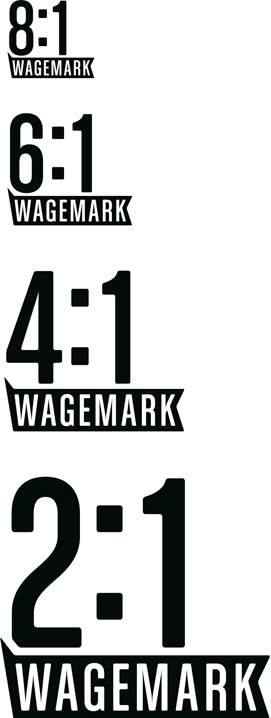
At its extremes, income inequality can appear staggering. In the United States where the issue has become a political flashpoint, Fortune 500 CEOs routinely make about 300 times the wages and benefits of their average workers. Ron Johnson, the former CEO of J.C. Penney, earned 1,795 times as such as the average employee of the department stores in 2012 — though it clearly didn’t reflect performance since he was bounced from his job after just 18 months last April. In Canada, research by the Canadian Centre for Policy Alternatives puts average compensation for Canada’s top 50 CEOs at 235 times the wage of the average Canadian.
While the economic effects of these discrepancies are hotly debated, there is a growing consensus that their visibility has a corrosive social effect. Enter the Toronto-based Wagemark Foundation, which aims to alleviate the most egregious disparities with a certification program aimed at persuading companies, government agencies and nonprofits to maintain a ratio of no more than 8:1 between the top-paid executive and the lowest-paid 10 percent of workers. Those that do would receive a Wagemark certification, akin to the green labelling denoting products that meet a defined set of environmental standards.
Given the state of inequality, bringing current wage disparities down to an 8:1 ratio might seem to be a quixotic challenge. But Peter Macleod, director of the Wagemark Foundation, stresses that the 8:1 benchmark was not designed for Fortune 500 companies. In its first phase, he hopes that Wagemark will gain traction within a network of small and medium-sized businesses, not-for-profits and public institutions, where he believes the standard won’t be such a hard sell. “Gross disparities don’t exist in these areas, and we have to start where success is likely,” Macleod says.
Macleod sees three avenues for incorporating Wagemark into the Canadian public sector. He first wants to set the salaries of members of Parliament to a Wagemark-certifiable multiple of Canada’s average individual income — perhaps three or four times. Second, he aims to push public institutions such as universities and hospitals to pursue Wagemark certification. Third, he wants to build Wagemark into the government procurement process by awarding bid points to competing firms that meet the Wagemark standard of income equality.
The question is whether it would succeed. Any policy that attempts to reduce the range of wages must either increase wages at the low end, decrease wages at the high end or do both simultaneously. Take a hospital, which employs everything from a receptionist to a chief executive officer. To become Wagemark certified, either the hospital would have to increase the salaries of all receptionists to justify the continuation of high-end salaries, or the CEO would have to take a significant pay cut.
The first option would result in the hospital either hiring fewer receptionists (because they are more expensive) or maintaining their number but then facing higher overall labour costs — which means the overall tax burden on Canadians would have to rise to pay the higher bill. The second option would clearly reduce the hospital’s ability to recruit at senior levels, as potential CEOs would compare the salary with the salaries on offer in other hospitals. A reduced ability to hire the best person for the job may result in poorer hospital direction and maybe even lower-quality health care being delivered. Applied to the private sector, the increased cost burden or reduced recruiting ability would simply fall instead on the firm’s owners and customers rather than on the taxpayers.
A more promising idea may be Wagemark’s stamp of approval as an element of the government’s procurement process. Adding the Wagemark certification to the growing list of qualities by which bidding firms are assessed “is an interesting concept and likely wouldn’t be rejected out of hand,” said Senator Hugh Segal, who sees Wagemark as an overdue yardstick by which to measure company and institutional performance on wage disparities. Yet despite seeing potential for Wagemark in the government procurement process, Segal adds that “part of why governments outsource is because the outside companies can do it at a lower cost than government could on its own.” A candidate firm looking to comply with Wagemark standards would be required to absorb higher labour costs, leading to a more expensive product and a more costly contract for the government.
An increased cost burden for firms pursuing wage equality is not an insurmountable obstacle. If the wage standard were imposed on (or voluntarily adopted by) all companies, a new norm would result and firms or public institutions competing for qualified labour would not see Wagemark compliance as detrimental to its competitiveness or profitability.
But for Wagemark’s vision to gain traction and reduce income inequality, it must find resonance with large numbers of consumers. If wage equality can become a “brand” the way the green movement has become over the past decade, the odds improve that companies and institutions will feel compelled to comply. Segal points out that Wagemark is not the only wage standard out there, and it surely will not be the last. “It is a yardstick around which companies will be forced to explain why they can’t achieve the 8:1 ratio, and it is long overdue,” he says. Meanwhile, Macleod is pleased that Wagemark is keeping the heat on trying to reduce the degree of income inequality. “Even if the business mentality isn’t there yet,” says Macleod, “isn’t it great we’re all talking about it?”







